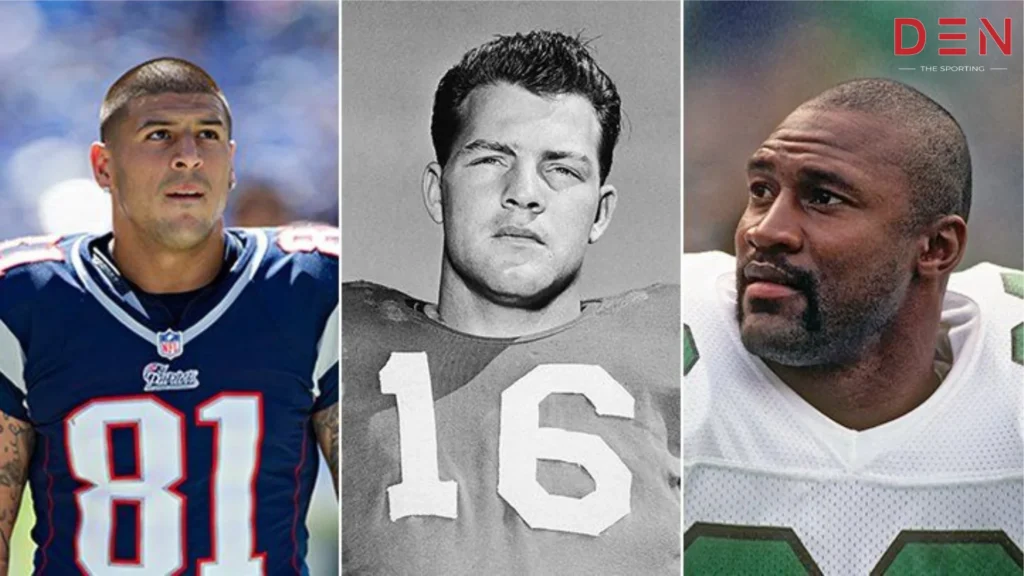
Head trauma and the consequential diagnosis of Chronic Traumatic Encephalopathy (CTE) among NFL players have thrust the issue into the spotlight, posing a significant challenge to the sport’s future. CTE, a degenerative brain disease linked to repetitive head injuries, remains only detectable posthumously. As the NFL grapples with the repercussions, the alarming prevalence of CTE among former players is sparking crucial conversations around player safety and the long-term consequences of a career in football.
Let’s delve into the details of the 10 Most Shocking CTE NFL Players Deaths.
Shocking CTE NFL Players Deaths: The Grim Reality of CTE, Understanding the Symptoms
CTE is accompanied by various incapacitating symptoms such as aggression, impaired judgment, impulsivity, paranoia, rage, and irritability. Given the absence of a cure, attention has turned towards prevention, particularly as a striking 99% of examined football players’ brains exhibit indications of CTE. The severity of the matter is emphasized by research indicating that as few as 10 impacts in a game could equate to the force of a 30-mile car collision.
Suggested Read: What time does 2024 Super Bowl start and end?
Shocking CTE NFL Players Deaths: Rethinking Head Injuries in the NFL
Historically, head injuries were considered an inherent risk in football. However, as the toll on players’ health became evident, the NFL has been compelled to reassess its stance on head trauma. This shift in perspective reflects an evolving understanding of the long-term impact of concussions and the imperative to prioritize player safety.
Exploring the 10 Most Shocking CTE NFL Players Deaths
Delving into the tragic outcomes of former NFL players diagnosed with CTE, we encounter stories that highlight the profound impact of head injuries on mental health, behavior, and overall well-being.
10. Frank Gifford: The Champion with a Silent Struggle
Frank Gifford, an NFL champion and Pro Bowler, retired in 1964 after a notorious concussion. While he passed away at 84 from natural causes in 2015, posthumous revelations confirmed he was a CTE-diagnosed player.
9. Dave Duerson: A Defensive Legend’s Tragic End
Dave Duerson, a celebrated safety, won two Super Bowls but suffered ten concussions during his career. His life took a tragic turn when, battling memory loss and erratic behavior, he died by suicide in 2011, leaving a final plea for his brain to be used for research.
8. Ray Easterling: Safety’s Struggle Beyond the Field
Ray Easterling, an 8-season safety, battled clinical depression and dementia before his suicide at 62. His autopsy confirmed CTE, and his legal action against the NFL for concussion handling further underscored the systemic issues players faced.
7. Chris Henry: The Troubled Wide Receiver
Chris Henry, a talented wide receiver, faced legal issues off the field before a fatal fall from a moving truck. His brain, donated for research, revealed the shocking truth – he was the first active player diagnosed with CTE, prompting the NFL to reevaluate its approach.
6. John Mackey: A Tight End’s Legacy Marred by Dementia
John Mackey, a tight end legend, revolutionized his position but later suffered from frontotemporal dementia. His posthumous diagnosis of CTE highlighted the ongoing impact of head injuries even after retirement.
5. Jerry Seau: Pro Bowl Linebacker’s Tragic Descent
Jerry Seau, a 12-time Pro Bowler, showcased explosiveness on the field. However, his life spiraled post-retirement, leading to insomnia and, ultimately, suicide. The diagnosis of CTE posthumously added another layer to the complex issue.
4. Jovan Belcher: A Shocking Turn of Events
Jovan Belcher, an undrafted linebacker, played four seasons before a tragic incident led to the murder of his girlfriend and his subsequent suicide. Postmortem examinations confirmed CTE, raising questions about the link between the disease and violent behavior.
3. Aaron Hernandez: A Fall from Stardom to Infamy
Aaron Hernandez, a Patriots tight end, achieved success on the field but faced legal troubles off it. Convicted of murder, he displayed signs of paranoia and severe CTE, highlighting the association between the disease and criminal behavior.
2. Justin Strzelczyk: The Dark Depiction in ‘Concussion’
Justin Strzelczyk, an offensive tackle, confided in teammate Mike Webster about memory loss and domestic issues. His life ended tragically in a car crash after a police chase, and subsequent CTE diagnosis emphasized the need for systemic change.
1. Mike Webster: The Hall of Famer’s Heartbreaking Decline
Mike Webster, a Hall of Famer, won four Super Bowls with the Steelers but faced a harrowing post-retirement life. From erratic behavior to homelessness, his heart attack at 50 was a culmination of CTE’s devastating effects, prompting a reevaluation of player care.
Suggested Read: Unveiling 10 Most Hated NFL Teams in 2023: Who Tops the List?
FAQs
The Boston University CTE Center studied the brains of 376 deceased former NFL players and diagnosed 345 of them with chronic traumatic encephalopathy.
The latest study expands upon discoveries outlined in a 2017 research, which revealed the presence of CTE in 99% of NFL players’ brains, 91% of college football players, and 21% of high school football players within the UNITE brain bank.
While chronic traumatic encephalopathy (CTE) currently lacks a cure, various medications and therapies can alleviate symptoms. Individuals suspected of having CTE receive support akin to the assistance provided to those with dementia.
NFL’s official website: (https://www.nfl.com/) and reputable entertainment news websites.
Summing it Up: A Call for Change
In conclusion, the 10 most Shocking CTE NFL Players Deaths shed light on the profound impact of head injuries on players’ lives, both during and after their careers. The narratives of these unfortunate incidents highlight the critical importance for the NFL to prioritize thorough player safety protocols, allocate resources towards research, and take proactive steps to mitigate the long-term impacts of the sport. As the league navigates the intricate dynamics of sports and brain health, recognizing and drawing lessons from these accounts becomes essential in sculpting a safer trajectory for NFL athletes.
David Conn, a distinguished sports journalist with 20 years of experience, is a trusted voice in sports reporting. Known for his precision in dissecting NFL plays, analyzing NHL strategies, exploring soccer finesse, and diving into basketball tactics, Conn brings an unwavering commitment to storytelling. Join us as we explore the dynamic world of sports through Conn’s nuanced understanding of athletes, strategies, and narratives in NFL, NHL, football, soccer, basketball, and more.



